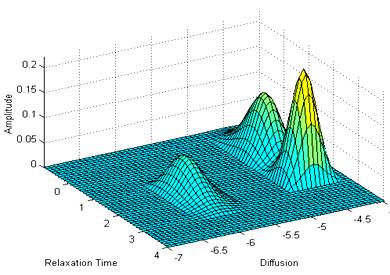Although one-dimensional spectra such as relaxation spectra and diffusion spectra have achieved great success in the analysis of core properties, a single parameter or one-dimensional spectrum often cannot fully reflect the properties of the RMN de núcleo de roca and the distribution of oil and water in the core. One-dimensional spectrum cannot distinguish oil from water very clearly. En años recientes, a variety of two-dimensional spectroscopy techniques have emerged, which can comprehensively reflect the distribution of oil and water in the core and the wettability information.
These techniques mainly include diffusion-relaxation two-dimensional spectra, t1-t2 two-dimensional spectra, t1-Two-dimensional chemical shift spectrum. These two-dimensional spectra greatly improve the oil-water discrimination ability of NMR spectroscopy, and provide richer information about the properties of the fluid in the core, especially the diffusion-relaxation two-dimensional spectra, which can achieve good results in pulse gradient fields and also Measurement in a constant gradient field has achieved remarkable results in fields related to actual production, such as oil logging. The research of diffusion-relaxation two-dimensional spectroscopy in oil-water saturation, oil-water distribution, wettability, etc.. has achieved results that cannot be achieved by previous one-dimensional spectroscopy techniques.
Due to the large inhomogeneity of magnetic permeability inside the core, the stronger the magnetic field, the stronger the inhomogeneity of the magnetic field inside the core (eso es, the built-in gradient), and the more serious the additional interference to the NMR signal. Por lo tanto, most cores can only be used to measure relaxation time and diffusion coefficient under low-field conditions to avoid the influence of strong magnetic field inhomogeneity on the measurement results. Sin embargo, the NMR signal intensity is generally low under low-field conditions, which puts forward higher requirements on the accuracy, estabilidad, and signal-to-noise ratio of NMR instruments. This research adopts the nuclear magnetic resonance system independently developed by the Magnetic Resonance Research Group of the School of Information Science and Technology of Peking University. It has reached the international advanced level in terms of magnetic field uniformity, probe dead time, and gradient strength. Good results have been achieved in rate measurement, and stable and accurate one-dimensional relaxation spectra and diffusion-relaxation two-dimensional spectra can be obtained.
The diffusion-relaxation two-dimensional spectroscopy technology is a technology that simultaneously obtains the distribution of the measured sample in the diffusion coefficient and relaxation time. It requires that the pulse sequence used in the measurement process can simultaneously complete the diffusion coefficient and relaxation time. The measurement of various parameters, and the observation signal measured by the instrument is superimposed by the signal generated by the components with different diffusion coefficients and relaxation times. It is necessary to establish an accurate and fast inversion algorithm to obtain the required data from the observation signal. The two-dimensional spectrum. After obtaining the diffusion-relaxation two-dimensional spectrum, appropriate data processing and theoretical analysis are required to extract key information that can reflect the distribution of oil and water in the core, which lays a good foundation for further research on the process of oil and water migration and improvement of oil recovery. basis.
 mohoso
mohoso
